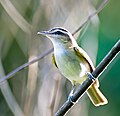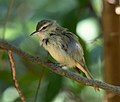Vireo (genus)
Genus of birds From Wikipedia, the free encyclopedia
Vireo is a genus of small passerine birds restricted to the New World. Vireos typically have dull greenish plumage (hence the name, from Latin virere, "to be green"), but some are brown or gray on the back and some have bright yellow underparts. They resemble wood warblers apart from their slightly larger size and heavier bills,[2] which in most species have a very small hook at the tip.[3] The legs are stout.[2]
| Vireo | |
|---|---|
 | |
| Chivi vireo (Vireo chivi) | |
| Scientific classification | |
| Domain: | Eukaryota |
| Kingdom: | Animalia |
| Phylum: | Chordata |
| Class: | Aves |
| Order: | Passeriformes |
| Family: | Vireonidae |
| Genus: | Vireo Vieillot, 1808 |
| Type species | |
| Muscicapa novaeboracensis[1] = Tanagra grisea Boddaert, 1783 | |
| Species | |
|
See text | |
Most species fall into two plumage groups: one with wing bars and yellow or white eye rings, and one with unmarked wings and eye stripes; however, the Chocó vireo has both wing bars and eye stripes.[3]
Sexes are alike in all species except for the black-capped vireo, in which the male's crown is black and the female's is gray.[3]
Taxonomy
The genus Vireo was introduced in 1808 by the French ornithologist Louis Pierre Vieillot.[4] The type species was subsequently designated as the white-eyed vireo (Vireo griseus) by German ornithologist Hans Friedrich Gadow in 1883.[5][6] The word vireo was used by Latin authors for a small, green, migratory bird, probably a Eurasian golden oriole, but a European greenfinch has also been suggested.[7]
Feeding
All members of the genus mostly eat insects and other arthropods, but also eat some fruit.[3] A common pattern is arthropods in summer and fruit in winter.[2] Vireos take prey from leaves and branches and in midair, and the gray vireo takes 5% of its prey from the ground.[3]
Range and territorial behavior
Most species are found in Central America and northern South America. Thirteen species occur farther north, in the United States, Canada, and Bermuda;[8] of these, all but Hutton's vireo are migratory. Vireos seldom fly long distances except in migration.[3]
The resident species occur in pairs or family groups that maintain territories all year (except Hutton's vireo, which joins mixed feeding flocks). Most of the migrants defend winter territories against conspecifics. The exceptions are the complex comprising the red-eyed vireo, the yellow-green vireo, the black-whiskered vireo, and the Yucatan vireo, which winter in small, wandering flocks.[3]
Voice and breeding
Summarize
Perspective
Males of most species are persistent singers. Songs are usually rather simple, ranging from monotonous, in some species of the Caribbean littoral and islands, to elaborate and pleasant to human ears in the Chocó vireo.[3] Calls often include "scolding chatters and mews".[2]

The species whose nests are known all build a cup-shaped nest that hangs from branches. Its outer layer is made of coarse leaf and bark strips or of moss, depending on the species; in either case, the material is bound with spider silk and ornamented with spider egg cases. The lining is made of fine grass stems neatly circling the cup. In most species, both sexes work on the nest, but the female adds the lining. In the red-eyed, black-whiskered, Yucatan, and Philadelphia vireos, the male does not help, instead singing and accompanying the female while she builds the nest. The female does most of the incubation, spelled by the male except in the red-eyed vireo complex.[3]
The eggs are whitish; all but the black-capped and dwarf vireos have sparse, fine brown or red-brown spots at the wide end.[2][3] Tropical species lay two, while temperate-zone species lay four or five. Incubation lasts 11 to 13 days, and the young fledge after the same amount of time. Both sexes feed the nestlings arthropods, and each fledgeling is fed by one parent or the other (not both) for as long as 20 days.[3]
Species
Summarize
Perspective
The genus contains 34 species:[9]
| Group | Image | Scientific name | Common Name | Distribution |
|---|---|---|---|---|
| The "hypochryseus" group |  | Golden vireo | Vireo hypochryseus | Mexico |
| The "olivaceous" group |  | Yellow-green vireo | Vireo flavoviridis | southern Texas, Mexico (the Sierra Madre Occidental and Sierra Madre Oriental—also the Cordillera Neovolcanica) south to central Panama |
 | Red-eyed vireo | Vireo olivaceus | Canada and the eastern and northwestern United States, Argentina, Uruguay, Paraguay and Bolivia | |
 | Yucatan vireo | Vireo magister | Belize, Honduras, Mexico | |
 | Black-whiskered vireo | Vireo altiloquus | southern Florida, USA, and the West Indies as far south as the offshore islands of Venezuela | |
 | Chivi vireo | Vireo chivi | northeastern Colombia, into Venezuela and the entirety of the Guianas into eastern Brazil | |
 | Noronha vireo | Vireo gracilirostris | Fernando de Noronha, Brazil | |
| The "gilvus" group | Tepui vireo | Vireo sclateri | western Guyana and northern Brazil | |
 | Philadelphia vireo | Vireo philadelphicus | Canada to Central America | |
 | Warbling vireo | Vireo gilvus | Alaska to Mexico and the Florida Panhandle | |
 | Brown-capped vireo | Vireo leucophrys | Southern Mexico south to northwestern Bolivia | |
| The "eye-ringed" group |  | Hutton's vireo | Vireo huttoni | southern British Columbia in Canada to central Guatemala in Central America |
 | Gray vireo | Vireo vicinior | southwestern United States and northern Baja California to western Texas | |
 | Yellow-throated vireo | Vireo flavifrons | southern United States, Mexico, the Caribbean, and Central America | |
 | Yellow-winged vireo | Vireo carmioli | Costa Rica and western Panama | |
 | Choco vireo | Vireo masteri | western Colombia and north-west Ecuador | |
 | Blue-headed vireo | Vireo solitarius | Canada and northern United States | |
 | Cassin's vireo | Vireo cassinii | southern British Columbia in Canada through the western coastal states of the United States. | |
 | Plumbeous vireo | Vireo plumbeus | southeastern Montana and western South Dakota south to the Pacific coast of Mexico | |
 | Blue Mountain vireo | Vireo osburni | Jamaica | |
 | Flat-billed vireo | Vireo nanus | Hispaniola | |
 | Mangrove vireo | Vireo pallens | Belize, Costa Rica, El Salvador, Guatemala, Honduras, Mexico, and Nicaragua | |
 | Providencia vireo | Vireo approximans | Isla de Providencia | |
 | Cozumel vireo | Vireo bairdi | Mexico | |
 | San Andres vireo | Vireo caribaeus | islands of St. Andrew (or San Andrés) and Providencia | |
 | White-eyed vireo | Vireo griseus | eastern United States from New England west to northern Missouri and south to Texas and Florida, and also in eastern Mexico, northern Central America, Cuba and the Bahamas | |
 | Thick-billed vireo | Vireo crassirostris | West Indies in the Bahamas, Turks and Caicos Islands, Cayman Islands, Tortuga Island in Haiti and Cuba | |
| Jamaican vireo | Vireo modestus | Jamaica | ||
 | Cuban vireo | Vireo gundlachii | Cuba | |
 | Bell's vireo | Vireo bellii | Western North America and Central America | |
 | Puerto Rican vireo | Vireo latimeri | Puerto Rico | |
 | Black-capped vireo | Vireo atricapilla | south from south-central Kansas through central Oklahoma and Texas to central Coahuila, Mexico | |
 | Dwarf vireo | Vireo nelsoni | Mexico | |
 | Slaty vireo | Vireo brevipennis | southern Mexico | |
References
External links
Wikiwand - on
Seamless Wikipedia browsing. On steroids.
